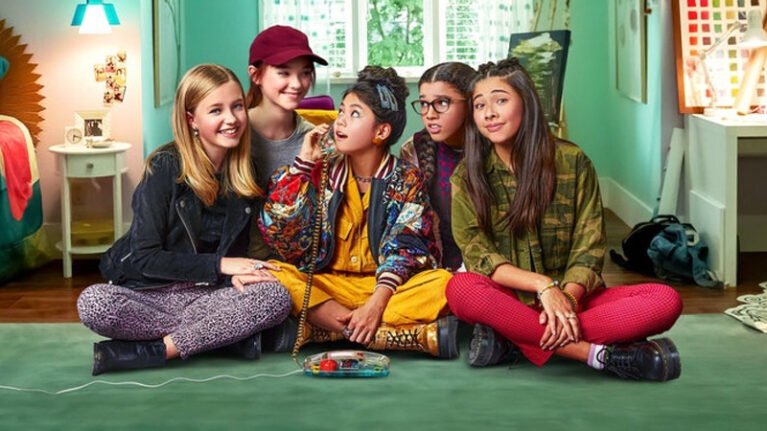I binge-watched the entire season of the Netflix show The Baby-Sitters Club the day it was out. Adapted from the popular series of books by Ann M. Martin (most of the later books were ghostwritten by other writers), it tells the story of a group of young girls in Stonybrook, Connecticut, who start their own club to baby-sit the children in their neighbourhood. Through this premise, Martin (and the series) also talks about each of their individual lives and families, dreams and aspirations, likes and dislikes.

When I think back on my time reading The Baby-Sitters Club, I immediately picture the library in my school. It was this gigantic room, with high ceilings, with smaller rooms opening up out of it. I remember the brown wooden cupboards and I remember the shelf in the junior library where the books in the series were kept. I don’t know if my school had the entire series but it definitely had a large number of the books, and I read them methodically. When I was allowed to issue only one book a week, I’d pick one, read it in the next period, and then go through my entire class, reading the books they had picked up as well. My most vivid memory of class 4 was when my mother was told at the parent-teacher meeting that I read entirely too much and I couldn’t possibly be allowed to read Harry Potter under my desk while I was supposed to be doing sums. I couldn’t imagine what I had done wrong—my sums were done, and all correct.
I’ve thought a lot about what fascinated me about The Baby-Sitters Club. And watching the series now makes me realise some of the things that could have appealed to a child growing up in Calcutta in the early 2000s. Stonybrook and the lives the girls led were so distant from my own, so different, that I had to devour the stories to understand that people could be that different, and have such a different childhood from mine. Yet the books were relatable because so many of the problems were common, so much of the teenage experience was universal.
“My most vivid memory of class 4 was when my mother was told at the parent-teacher meeting that I read entirely too much and I couldn’t possibly be allowed to read Harry Potter under my desk while I was supposed to be doing sums. I couldn’t imagine what I had done wrong—my sums were done, and all correct.”
Each of the Club’s members have a distinct personality and each book is narrated by a different member, in turns. We learn of Kristy’s large family, of Claudia’s perfect sister Janine, of Mary-Anne’s over-protective father, and Stacey’s health issues. We’re introduced to more characters, new friends and boyfriends as the series progresses. They all have similar issues—low grades, unsympathetic teachers, different extracurriculars.
I remember identifying with Kristy when she was jealous that Dawn would become Mary-Anne’s best friend, which she had been all their lives. Growing up and making new friends isn’t always easy for everyone, which is something both Kristy and I struggled with. We also weren’t great with accepting that things could change, or that our friends would have other friends too. I think it was this insecurity of Kristy’s that appealed most to me. She’s always been my favourite for that reason. I remember feeling Mary-Anne’s frustration because her dad was so strict and had so many rules and curfews. I remember getting annoyed with Janine because she was so smart and perfect and all Claudia wanted to do was be creative. Looking back, I’m surprised Claudia wasn’t my favourite—I’ve always identified a lot with younger siblings in novels who have overachieving elder siblings. I know I fell in love with Ron Weasley the moment he told Harry that everyone expects a lot from him because of his brothers, but it won’t be a big deal if he does achieve things, because his brothers have done them first. As a younger sibling, I have rarely related to anything more.
What I didn’t relate to was the world of Stonybrook. I was nine or ten when I read the books, the girls were eleven or twelve. I had never heard of baby-sitters before. I couldn’t wrap my head around the fact that they were allowed to take care of younger kids, often even toddlers. I was barely allowed to cross the road alone. Yeah, sure, my parents were stricter than most, but I hadn’t even seen my friends have some of these privileges. And I was sure that none of my friends would know how to take care of younger kids, or take them swimming or to dance lessons, or help with first-aid. This was a completely different world for me. I want to, at this point, acknowledge my privilege. I know that girls much younger than I was then, often have to take care of younger siblings, cook and clean for them, help them bathe and dress and study. The difference is that they’re either not paid for this labour, or if they work as domestic help, it’s often under trying circumstances. The Baby-Sitters Club was not forced to take up this work. It was a hobby group that also earned them some money. I know now, of course, that babysitting is a popular way to earn a little pocket money for kids abroad, but it felt so new and different back then.
Their families were also very different from ours. Many had single parents—Mary-Anne’s mother had died when she was a child, Dawn’s parents were divorced, as were Kristy’s. The complete matter-of-fact way in which this was addressed was completely shocking to me then. Very few of my friends’ parents were divorced—if they were, it wasn’t something that was ever addressed or explained. The whole sub-plot of Mary-Anne’s dad dating Dawn’s mom and the girls’ reaction to it would not have taken place in the Calcutta I grew up in. The first few books in the series also talk about Kristy’s mom dating Watson, and how Kristy doesn’t like him. (She doesn’t like change, and she’s insecure, remember.) I doubt any of my friends or classmates would have been comfortable even sharing the fact that one of their parents was dating someone, forget the details and the drama surrounding that. In the world of Stonybrook, however, it’s a constant topic amongst the group of friends. They hash it out between themselves, trying to understand Kristy’s point of view, but also seeing her mom’s, and they share the excitement of the wedding when it takes place.
I would lap up these stories as a child. I wanted to know what happened next, especially with the story threads that spanned across books. It’s no wonder then that I love the Netflix series, which has done a great job of transposing their lives to 2020. The story in the T.V adaptation remains faithful to the books, but the show’s creators have added their own layers to the stories, complete with issues like transgender rights, and internment camps. It’s an endearing look at teenage female friendships—as they navigate parents and first crushes and first periods. The girls in the series are far from unidimensional. They’re real and it’s very refreshing to see that in this adaptation of the book series.
“The Baby-Sitters Club is an endearing look at teenage female friendships—as they navigate parents and first crushes and first periods.”
I love that the Baby-Sitters Club doesn’t trivialise the issues that the girls face, just because they’re kids. These issues have larger meaning and often much greater significance and the show acknowledges that. I love the nostalgia that the show invokes and almost revels in, but I also love the new-ness of the show. And meeting the Baby-Sitters Club again was, of course, something I enjoyed.
I’m 26 now. I’m no longer so wide-eyed in wonder about teenage life in America (only a little wide-eyed). But I remember myself at 9 and 10 and 11. I remember the fascination I felt for these smart, exciting, independent, badass girls. And I love that they’re still badass.








